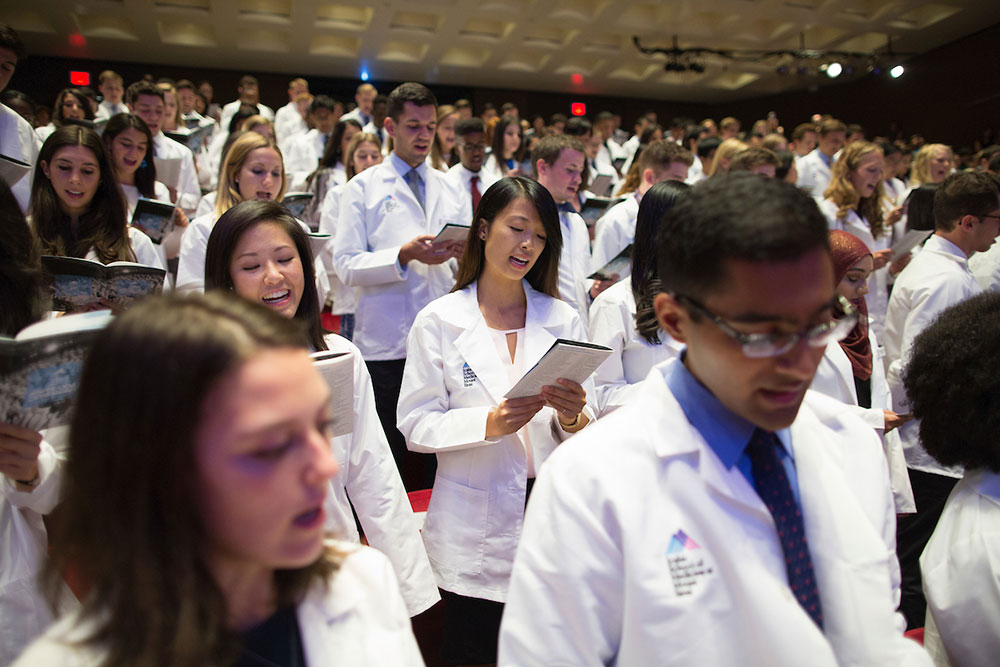Every year, students at the Icahn School of Medicine write Op-Ed articles about topics in health care and advocacy to culminate InFocus 4. Olga Salianski’s article, “What to Do with Illegal Immigrants and Are We Scared of the Wrong Monster?” was one of the 10 exemplary articles selected to appear in the 2016 issue of Physicians as Advocates—InFocus 4. We share her story.
Nice to meet you, I’m the boogeyman. I am one of the people you are taught to fear—the illegal immigrant. Indeed, I once spent two years in this country as one of its 11 million illegal immigrants. Years have passed since then; I have gone through a long and arduous asylum process to become an American citizen, and now that I have the privilege and protection of citizenship, it is my duty to speak on behalf of those who can’t.
The anti-illegal immigrant rhetoric is built on the myth that “the illegals” are scary and dangerous people who bring drugs and crime and who take jobs from Americans. They drain our resources and perpetrate violence against us. Life will be great only when the last bus full of deportees crosses the Mexican border! This nebulous but terrifying image of “the illegals” has successfully attracted many Americans to the political candidates who promise to deliver them from the evils of illegal immigration.
This image also couldn’t be further from the truth. As an illegal immigrant myself, I lived, worked and made friends with many others like me. What I learned from that experience was that we the illegal immigrants were in fact among the most hard-working and yet the most defenseless people in this country.
First of all, none of us “illegals” would ever dream of committing a crime or doing anything that could lead to arrest and deportation. In our effort to stay under the radar of immigration authorities, we were the most law-abiding New Yorkers. Conversely, we were often on the receiving end of violence and crime at the hands of those who knew our status and knew we would be too scared to go to the police no matter what was done to us. An example of this was my first job.
I was an enamel painter at a jewelry manufacturing facility in Queens, where almost all other workers were illegal immigrants as well. We created enamel designs on gold jewelry to be sold at fine department stores. We worked 14-hour days in a dirty, poorly ventilated room, handling smelly, toxic chemicals with our bare hands. An industrial-size air compressor roared behind our backs, giving us one migraine after another. A month into this job, my hands became covered with an itchy, painful rash which cracked, bled and made washing my hands feel like waves of electric shock were spreading through my body. I had no health insurance and no money to see a doctor. Neither did the rest of my co-workers whose hands, elbows and faces broke out the same way.
For our work, we were paid pennies of commission, and if the boss wasn’t happy with the result, he threw our day’s work into a bucket of paint stripper and paid us zero. The worst part, however, wasn’t the money or the lack of employee benefits. It was the abuse. The boss would scream insults in our faces, throw things, curse and call us stupid. He made heinous sexual, racial and homophobic comments. He groped women and put a metal detector to their breasts looking for body piercings.
And yet no matter what happened, everyone came back to work the next morning because everyone had important reasons to be there. Some of us had escaped from persecution by dictatorial political regimes; some were nearly killed for being gay in their home countries; many had families abroad who depended on the money they sent. With each illegal immigrant came a dramatic story, and sometimes a tragic one. Each one of us hoped for a better future for ourselves and our families, so we sacrificed our health and endured mistreatment.
Having experienced life on the other side of the “illegal” paradigm, I see how absurd it is to demonize and blame illegal immigrants for this country’s problems. They are invisible and powerless, denied of basic humanity, living in dingy basements and doing jobs no one else in their right mind would ever agree to do. Instead of spending billions of dollars on deporting these already marginalized people, how about we give them work permits and essential human rights? That’s all they ask for. In return for this gift, I know they will fully dedicate themselves to making their new home country a better place. And this, not mass deportation, can make America great again.
When asked about writing “What to Do with Illegal Immigrants and Are We Scared of the Wrong Monster?” for InFocus 4, Olga says:
Through writing my op-ed, I had a welcome opportunity to share my experience and voice my protest against social injustice. I believe that there is great power in exchanging our ideas with others, and the [InFocus 4] op-ed writing exercise provided us with a forum to do that.
Olga Salianski is an MD Candidate, Class of 2018. During her tenure in medical school, she has served on the board of the American Medical Women’s Association (AMWA) and chaired the 2016 Community Health Fair. Prior to medical school, Olga worked for a Fortune 500 company while earning her Bachelor’s degree in Psychology at Hunter College.












